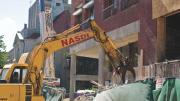A gut renovation of the Sherman Fairchild building this fall will yield 62,000 square feet of space for 275 investigators dedicated to stem-cell research, including faculty members, graduate students, technicians, postdoctoral fellows, and research assistants. The high-density open labs--211 net square feet per work station--are part of a design philosophy intended to foster collaboration that carries over from the unbuilt Allston science complex. When the $65-million to $70-million project is complete in the fall of 2011, there will be 16 faculty investigators engaged in stem-cell and regenerative biology in Cambridge here and in the adjacent Bauer Laboratory.
Harvard renovates building to create new labs for stem-cell research
Harvard renovates building to create new labs for stem-cell research
Harvard renews an older building to create new labs in Cambridge for stem-cell research.

You might also like
Sam Liss to Head Harvard’s Office for Technology Development
Technology licensing and corporate partnerships are an important source of revenue for the University.
Garber to Serve as Harvard President Beyond 2027
A once-interim appointment will now continue indefinitely.
Harvard Students, Alumna Named Rhodes and Marshall Scholars
Nine Rhodes and five Marshall scholars will study in the U.K. in 2026.
Most popular
Explore More From Current Issue

The 1884 Cannibalism-at-Sea Case That Still Has Harvard Talking
The Queen v. Dudley and Stephens changed the course of legal history. Here’s why it’s been fodder for countless classroom debates.

Introductions: Dan Cnossen
A conversation with the former Navy SEAL and gold-medal-winning Paralympic skier

A Near-Perfect Football Season Ends in Disappointment
A loss to Villanova derails Harvard in the playoffs.




